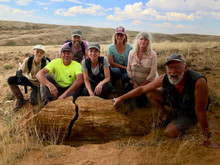Rockhounding, also referred to as rock hunting and mineral collecting, is the hobby of going out in the field to look for and collect interesting rocks.
I am writing a series of blogs that deal with this hobby. This series is mostly geared towards the beginner or hobbyist, not the commercial collector. But even a seasoned rockhounder might pick up some new tricks, so read on!
Before you venture out read my guide to the rules for rockhounding here:
https://www.oakrocks.net/rockhounding-rules/
On public lands you are allowed to collect rocks, mineral specimens, petrified wood, and invertebrate fossils. Do not collect dinosaur bones or vertebrate fossils (creatures with bones).
Also, steer clear of human artifacts, as these may be protected. This includes even simple items like stone tools, arrowheads and shards of pottery.
There is a plethora of websites and books that can get you started on where to go and what to collect. You just have to do a little research. Sometimes it is fun just to collect pretty rocks and not worry about value. You may have a local Lapidary Club that does field trips or knows of good areas to collect. There are also places that do Pay for Dig.
Here are my guides by state to get you started:
https://www.oakrocks.net/rocks-and-minerals-localities/
Today I want to talk about how you should prepare to go rockhounding and what you should take with you on your treasure hunting adventure.
You should always run a safety check on your vehicle, check brakes, tires, etc., if you are venturing off the beaten path. Make sure you have a spare, a tire iron and that the jack is in good working order. Your car should have basic traveling supplies. A first aid kit, blankets, jackets are a good idea, even in hot weather (the nights can get cold in the desert), water (lots of water), some snacks, a whistle, a lighter, a flashlight and a cell phone (even though you may not have service in some areas, 911 may still work), a portable or solar charger is a good idea-especially if you plan on using GPS or take a lot of pictures. If you have a GO Pack-take it! Start with a full tank of gas-and most important-TELL SOMEONE WHERE YOU ARE GOING AND WHEN YOU WILL BE BACK.
Obviously, how you dress will depend on the terrain you will be in and the weather you will encounter. Long pants may be better in high brush. Long pants and long sleeve shirts can protect you from scratches, insect bites, sunburn, etc.
Good footwear is important. Your shoes should be waterproof, if there is a chance of water or rain where you are going. Ankle support is good if you will be climbing over rocks and crevices. I recommend closed-toed shoes in case you accidently drop a rock! Make sure your shoes are worn in, wear thick socks and bring Band-Aids for blisters. High boots or even snake guards should be worn, if the area you are going to may have snakes. If there is a chance of rain consider a rain jacket, a poncho, or a trash bag. A hat is always a good idea and sunscreen is a must even on cloudy days.
A back pack is a good idea. Even if you don’t plan on traveling far away from your vehicle, you can carry your tools, snacks, water, and other supplies with you, and have them handy. You can use it, a vest with lots of pockets, or even a burlap or sand bag, or a bucket to collect in.
I also suggest carrying a pocket knife, sunglasses, insect repellant, a good pair of work gloves and toilet paper (not just for obvious reasons, but it’s good for wrapping delicate mineral specimens in too!).
As for tools-that’s up to you and may be dictated by the terrain, what you are hunting for, how close you can drive to the site, etc. Here are some suggestions:
A prospectors pick with a square hammerhead on one side and a pick point on the other, is probably the most important tool.
A shovel, a pry bar, various chisels, a sledgehammer, screwdrivers, super glue, a sieve or screen, a jeweler’s loupe or magnifying glass, brushes and/or a black light.
And finally, don’t forget to consider safety equipment: Safety glasses, a hard hat if you will be underground or under a high wall, and steel-toed shoes.
Next month we will talk about orientation and map reading! And in future blogs we will talk a little about hazards, mining claims, and geology or what rocks form where!
Be safe and happy hunting!
 US Dollar
US Dollar
 Australian Dollar
Australian Dollar
 Euro
Euro
 CAD
CAD

